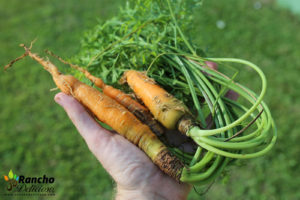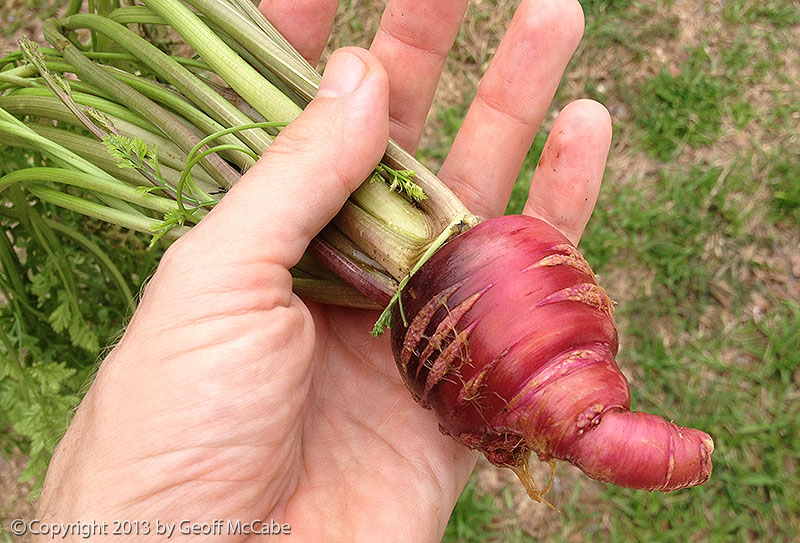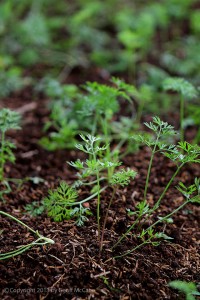Growing Carrots in the Tropics
How to Grow Organic Carrots in the Tropics
Note: This article is also available in Spanish/Español
-
Seeds: Very small, planted shallow
Soil Type: Sandy not clay, not rich in Nitrogen, excellent drainage
Ph: 6-6.5
Germination Time: 4-20 days
Spacing: Rows 25cm apart. Plants 10-15cm apart
Water: Daily
Sun: Full Sun
Harvest Time: 12-18 weeks
History and Nutrition
A member of the parsley family, carrots were first domesticated in Afghanistan around 2000 years ago. Its ancestor is the common weed plant Daucus Carota known as wild carrot in Europe and queen anne’s lace in the U.S. and Canada. It grows wild in Europe, Central Asia, and North America.
Originally carrots were red, purple, or black, but in the 1600;s the familiar yellow/orange variety was produced in Holland, which is now nearly the only variety sold in grocery stores in the United States. Most people are surprised and delighted to discover that carrots exist in other exciting colors, and these exotic shades are very popular with organic gardeners.
Carrots are famously known to be great for the eyes, and some experts have added them to their list of favorite superfoods. Eating too many of them can make your skin start to turn yellow. Some people claim that eating them prevents or reverses greying hair. They are very healthy raw, but due to the thick cell walls, produce quite a bit more antioxidant effect when cooked (preferrably steamed, not boiled or fried.) The most nutritional benefits can be derived from carrots by juicing them, which provides both benefits of cooked and raw carrots.
Soil Preparation
Costa Rica soil typically has a lot of clay, which carrots don’t like. Try adding 60%-80% sand mixed in with clay soil. Use raised beds, dug very deep and kept loamy. Do NOT add fertilizer. Some industrial growers use soil for growing carrots that’s nearly pure sand.
Planting
Carrot seeds are difficult to germinate. They must be kept moist at all times. Many successful carrot growers water the seeds twice a day.
Do not transplant them. Plant them directly into the area in which they are to grow.
Plant them very shallowly, since carrot seeds are very small. Many people mix them with sand or a very light loamy soil mixture and pour this carefully into shallow (1-1.cm) grooves, then cover this with sandy soil.
A technique that many use and swear by is this:
Using Wood Boards to Germinate Carrots
1. Mix the carrot seeds with sand
2. Prepare grooves in the soil, 25cm apart. The grooves should be 1-1.5cm deep and 3cm wide.
3. Poor the sand+seeds into these grooves and cover this with a thin layer of a mixture of 50% sand and 50% loamy soil.
4. Put wood boards over these grooves, such as old fence posts, 2x4s, or other small pieces of wood.
5. Push the boards down slightly to help the seeds get in contact with the soil.
6. Lift up the boards starting in 4-7 days to check if the seeds have germinated.
7. Raise the boards 2-4cm using risers of some kind, to give the seedlings room to grow.
8. After one week, remove the boards.
At Rancho Delicioso, we have also been able to germinate carrot seeds by covering the seeds with a layer of cut long grass, which helps keep them moist and gives them room to grow, but I suspect the wood board method described above would be better for many reasons.
Companion Planting
Good Companion Plants for Carrots (according to internet sources, not from experience): Onions, Leeks, Lettuce, Sage, Peas, Radishes, Tomatoes, Beans, Celery, Rosemary.
Bad Companion Plants: Brassicas (cabbage, kale, broccoli, cauliflower, brussel sprouts etc), Beetroot, Dill, Brassicas, Fennel
Growing Carrots
Once the carrot seedlings have started growing, you should thin them out periodically. When smaller, you can use the greens in salads. As they grow larger, you can eat the baby carrots, which may be sweeter but have been reported to be less nutritious (more bitter taste is often taken as evidence of more minerals/nutrition.) Eventually you’re looking to have carrots spaced in rows that are 25-30cm apart, with individual carrot plants spaced 10-15cm apart.
-
Cooling: Carrots prefer cooler weather but with full sun. They want well-drained soil that’s not too rich in nitrogen or compost.
Mulch: Mulch is extremely important for growing carrots in the tropics. Adding mulch around the seedlings is especially important to keep the carrot roots cooler. A dry mulch, not too rich in nitrogen or compost is ideal, such as cut grass and leaves. As the carrots grow you can add more of this to keep the soil cool and moist.
Composting: Don’t add compost! Carrots don’t need it and adding it will usually fuel the greens/leaves to grow while leaving the carrot root stumpy, or can cause them to fork into multiple roots.
Carrots grown in conditions that are too hot will generally be lighter in color and more bitter tasting.
Pests/Insects
Slugs/Snails: Attacking at night, these slimy pests eat all types of garden plants. Warning! Some slugs in Costa Rica are apparently poisonous to touch. It’s suggested that they don’t like broken up eggshells, because they’re sharp. Also, shredded peppermint/mint type herbs are good deterrents.
Mammals: rats, coatis, rabbits, and armadillos can dig them up to eat them. The best deterrent are cats and dogs.
Harvesting
Baby carrots can be harvested throughout the growing process, continually thinning them out, and generally they’re sweeter when they’re smaller.
Large Carrots should be able to be harvested in 12-18 weeks.
Warning! Carrot greens have been known to cause phytophotodermatitis, when the juice of carrot greens gets on your skin and then is exposed to intense UV sunlight. Some people can react with itching, pain, and blisters.
Are Carrot Greens Toxic?
The media loves to scare us with stories that go against conventional wisdom, and even the NY Times got into the act, declaring carrot greens to be toxic (Click here: NY Times – The Toxic Salad). Good article marketing involves writing article titles that get people to click and read, and scary stories that go against conventional wisdom are a quick and easy way for writers to drive up viewer metrics in their writing. This irresponsible journalism tactic doesn’t serve the greater good and here at Rancho Delicioso we’re trying to provide accurate, balanced, and thorough information without the hype.
This irresponsible journalism tactic doesn’t serve the greater good and here at Rancho Delicioso we’re trying to provide accurate, balanced, and thorough information without the hype.
A thorough reading on the subject of whether carrot greens are toxic or edible reveals that carrot Greens CAN be eaten, but not recommended in great quantities, due to the fact that they, like many greens, contain alkaloids, which are a class of organic chemicals that are toxic in large quantities. It’s for this reason that nutritionists, raw foodies, and juicing enthusiasts recommend that one must rotate greens. This means that you shouldn’t eat the same green leafy vegetable every day, but alternate between several varieties. This gives your body time to process different types of alkaloids so that no one type builds up to a toxic level in your body. At Rancho Delicios we’re growing as many edible green leaf vegetables as possible to make it easy to rotate between them.
Carrot greens are sold as edible greens in France and other farmer’s markets around the world, have been eaten for centuries, and are used in many recipes. They can be bitter, and some people don’t like them for that reason. Many people use them primarily for juicing for this reason.
Tips & Troubleshooting
Carrots too Stumpy: This is usually caused by too much nitrogen in the soil. The dirt is too rich. Don’t add compost. It can also be caused by soils that aren’t soft enough (too much clay). It can also happen when the roots are too hot. In the tropics, heavy mulch is needed for carrot growth.
Carrots Forking/Splitting: Many growers report that the carrots split and grow into multiple/Siamese roots, rather than as a single straight carrot. They taste the same, but are very difficult to clean since dirt gets stuck in the grooves. Typically this can be caused by too much nitrogen in the soil. Don’t add fertilizer or compost to growing carrots.
Radish Companion Planting: Radish is especially good as a companion plant, and the carrot and radish seeds can be mixed together with sand and planted. The radishes will grow first. Thin them out and eat the baby radish greens which are a great gourmet delicacy. The radish seedlings help to shade the baby carrots to keep them cool, and the radish bulbs grow near the surface of the soil, not competing much with the deeper-growing carrots.
Results: 2015/2016
 As of this writing, we’ve had lots of problems getting carrots to grow. The seeds don’t germinate. They take far too long to grow. When the carrots do grow, they’re all greens and little or no root (as shown on the red carrot photo above.) The photo on the right shows our best carrots so far, which took 5 months or so.
As of this writing, we’ve had lots of problems getting carrots to grow. The seeds don’t germinate. They take far too long to grow. When the carrots do grow, they’re all greens and little or no root (as shown on the red carrot photo above.) The photo on the right shows our best carrots so far, which took 5 months or so.
The reality is that it’s not really worth growing them yet. I don’t want to give up, and many people have told me they believe it’s possible. If I try again, I suspect they will work better in beds that are raised even higher, with lots of sand added for even better drainage. I also hope that somewhere out there are seeds for carrots that have been acclimatized to the tropical heat, but so far I haven’t found any.
Results: 2017
We have finally had some success with these. Using an organic purple carrot variety, we planted the seeds directly into beds that had 50% sand, our usual dirt, and no compost or extra nitrogen. These were raised beds, and underneath the plastic roof so we could control the amount of water they get. One of our workers, Frank, was given this project and told to protect, nurture, and love these carrots like they were his own children.
The results were that finally, we got carrots! They grew long and straight, and very tasty. However, the down side is that we let them grow too big, and in growing larger they became too bitter. The upside is that Frank did grow what could be called the world’s sexiest carrot, as seen on the left!
Our plan for next time is to plant them much closer together, and not grow them for so long. We’ll harvest them younger and sweeter, and there will be more of them. Who needs giant carrots anyway when we can just have more smaller ones, right?
More results to follow… it looks like we might finally crack the tropical carrot puzzle!
References
Carrot Museum – Great, long article with many details about growing carrots, nutrition, history, color, etc.
Gardenate.com – Tons of information, not just in the article but in the 120+ comments. Many of the ideas in this article were taken from the discussion here.

















